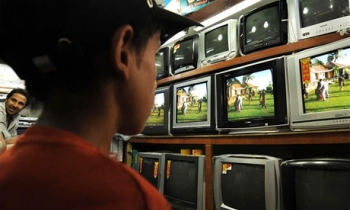It's hardly surprising that, as a Statistics Canada study released yesterday reveals, Canadians' level of political engagement is related to their news usage.
The more news they consume, the more they are involved "in non-voting political activities such as attending public meetings; searching for information on a political issue; volunteering for a political party; expressing their views by contacting a newspaper or politician; signing a petition; or participating in a march or demonstration."
That's what makes the wheels of democracy go 'round. But whether getting involved makes people more interested in news (or the other way around) isn't clear from the study, part of the 2003 General Social Survey.
And anyway, four years later, after the proliferation of PVRs (personal video recorders) and podcasting, satellite and Internet radio, plus the explosive popularity of blogs, open platforms for user-created content (such as YouTube) and social networking sites (like Facebook), the study is irrelevant.
And it was never very reliable to begin with, says Barry Kiefl of the Ottawa-based Canadian Media Research Inc.
"StatsCan has ventured into media research in the past with dubious results," he says. "Media research is a very specialized area of market research that requires specialized training."
Surveys rarely match Nielsen Peoplemeter ratings. Newspaper readership surveys aren't hard circulation numbers.
Nobody in the business will be bowled over to learn that over-45s tend to use news more frequently than younger people.
We're chasing younger audiences to ensure the future of mainstream news organizations. But it's tough. At 42 per cent, the Internet was the news source of choice for 19-to-24-year olds, or for those who actually pay attention to the news.
Young people have never been big consumers of TV newscasts or newspapers. It's been something they grow into – although in recent years they appear to be growing around it. Indeed, another report based on the 2003 General Social Survey showed that only 51 per cent of youth follow the news on a daily basis and there is a likely correlation between that and the low rates of youth voter turnout.
It would be nice to say that they're all surfing to get the latest from the BBC and CBC but, more likely, they're downloading new ringtones.
Oh, the news gets worse still.
With TV news outranking other sources in terms of frequency of usage – with 91 per cent of frequent news users saying they follow it versus the 70 per cent who track print – the report says TV is the "staple food of news consumption," particularly among the elderly, women and the less affluent.
But – and it's a big one – when it comes to political engagement, those who rely on TV as their sole source of news "closely mirrored those who did not follow the news at all."
Yelling at the TV does not count as a "non-voting political activity," at least not according to StatsCan.
Despite the unreliability and the obsolescence of the study, it does raise an interesting issue.
Despite its power and pervasiveness, television fails miserably at conveying complex policy issues and stories. It's often about sensation and celebrity, lowest common "dumb-nominator" for highest possible ratings.
Commercial TV rarely, if ever, seeks to engage viewers in the political process. It would be against the advertisers' interests to get viewers off the couch.
What's more, it rarely challenges the establishment. Ask yourself, for example, how much coverage of peace demonstrations you have seen in recent years, except when scuffles break out at the margins.
No wonder youth get so cynical. Unlike generations past, they can see – on their laptops or their iPods – evidence of the larger picture, such as the thousands who marched peacefully.
So why should they buy what the soap sellers are pushing?









